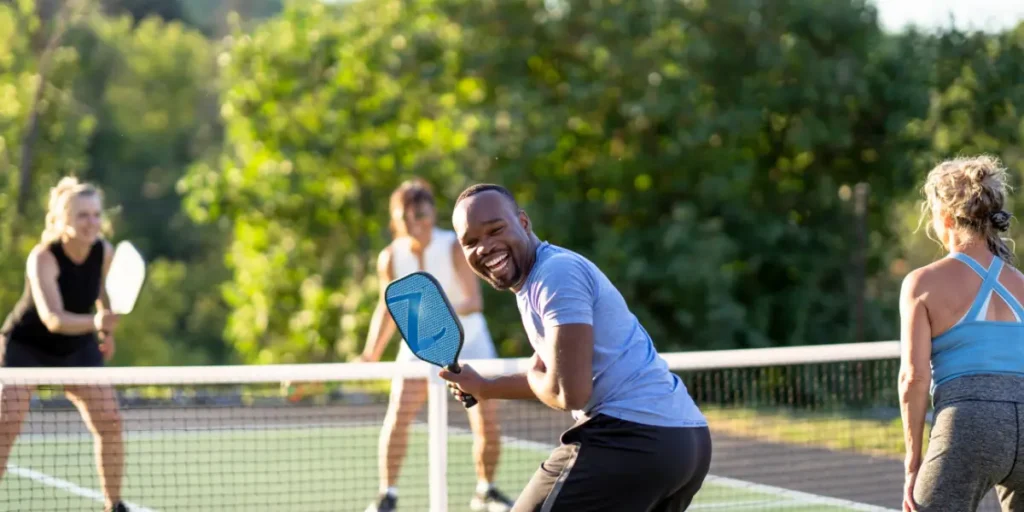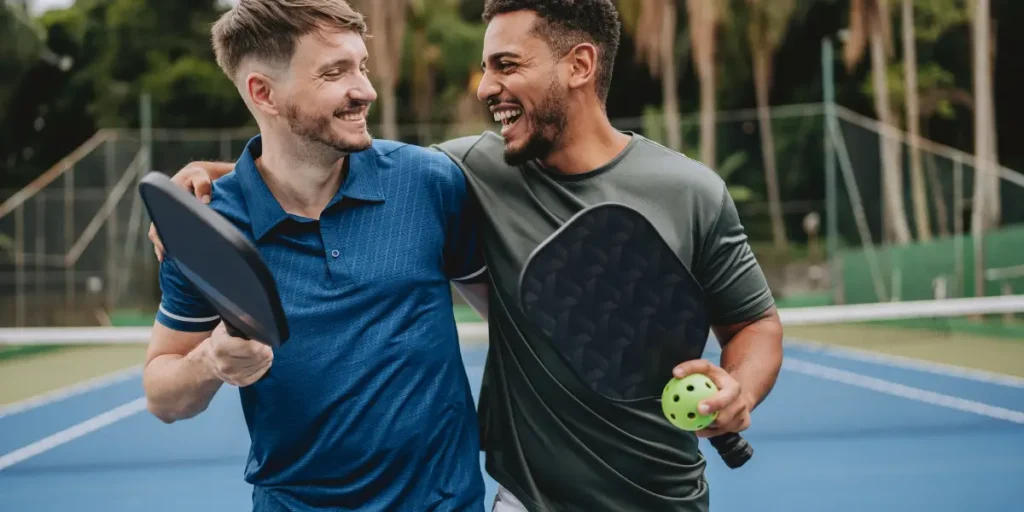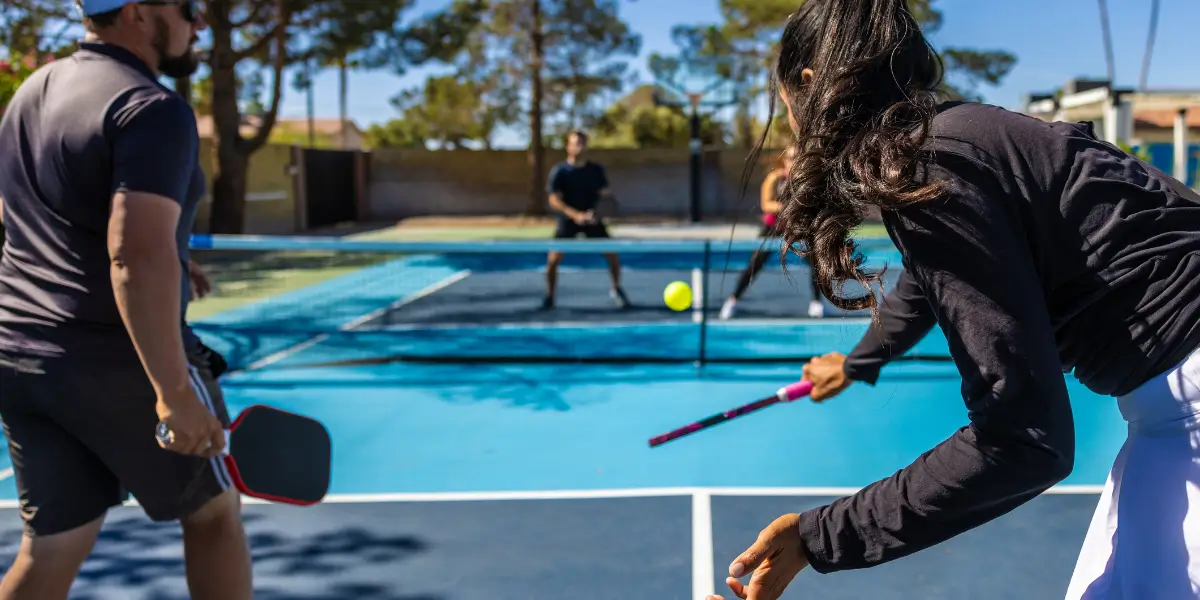If you’re new to pickleball or still building confidence on the court, the concept of a side out can be easy to overlook, but it’s one of the most important rules to understand. A side out happens when the serving team loses its right to serve, and control passes to the opposing side.
For beginners and intermediate players, knowing when a side out occurs and how it affects scoring is key to making better decisions during play.
In this guide, we’ll break down exactly what a side out is, how it works in singles and doubles, and how understanding it can help you avoid avoidable mistakes and improve your overall game awareness.
What is a Side Out in Pickleball?
In pickleball, a side out refers to a situation where the serving team loses its chance to serve, and the serve shifts to the opposing team. It doesn’t mean anyone scored a point, in fact, in traditional scoring, points can only be earned by the serving team.
A side out simply ends the current team’s serving opportunity due to a fault, error, or completed service rotation in doubles play.
For example, if you serve the ball into the net, out of bounds, or make a fault during a rally, you risk triggering a side out. Once the side out is called, your opponent gains the right to serve and the chance to start scoring.
It’s a core part of the game’s flow and can shift momentum quickly, especially in tight matches. That’s why understanding how and when a side out occurs is crucial, not just for rules, but for better strategy on the court.
When Does a Side Out Occur in Pickleball?
A side out occurs in pickleball when the serving team commits a fault and loses its opportunity to continue serving. In both singles and doubles, this can happen for several reasons, such as hitting the ball into the net, serving out of bounds, volleying from inside the non-volley zone (the kitchen), or simply losing the rally.
How Side Outs Work in Doubles Pickleball
In doubles pickleball, the concept of a side out is closely tied to the two-server rule. Each team starts a service turn with two opportunities to serve, one for each partner, before a side out occurs. This format adds a layer of strategy and rhythm to the game, but it also means players must be extra careful to avoid avoidable faults.

Here’s how it works:
- The player on the right-hand side serves first. This is known as the first server.
- If the first server commits a fault (like hitting the ball into the net or losing the rally), the serve passes to their partner, who becomes the second server.
- If the second server also faults, that’s when a side out occurs, and the opposing team gains the serve.
One important exception is at the very start of the game: only one player from the starting team serves before a side out is enforced. This balances the advantage of serving first.
How Side Outs Work in Singles Pickleball
Side outs in singles pickleball are simpler than in doubles because there’s only one server per side.
Each player serves from the appropriate side of the court, right when the score is even, left when it’s odd, and continues serving until they commit a fault. Once that happens, a side out is called, and the serve passes directly to the opponent.
There’s no “second server” in singles play. You serve until you lose the rally or commit an error, and then your opponent gets the serve. This straightforward rotation means fewer rules to remember, but it also makes every service opportunity more valuable.
You only get one chance per turn, so every mistake, especially an unforced one, can immediately shift control of the game.
Side Out and Traditional Scoring
In traditional pickleball scoring, still the most commonly used format, only the serving team can score points. This makes the role of the side out even more important, because it doesn’t just change possession of the serve, it ends your chance to score during that service turn.
Here’s how it plays out:
- If you’re serving and win the rally, you earn a point and continue serving.
- If you lose the rally, it results in either a second server taking over (in doubles) or a side out (in singles or after the second server in doubles).
- When a side out occurs, your team loses its chance to score until you regain the serve in a future rally.
For many beginners, this system can feel frustrating at first. You might play several rallies in a row but not see your score move, simply because you weren’t serving.

That’s exactly why understanding the concept of a side out is so important. It helps you value your service opportunities more strategically, focus on high-percentage shots, and reduce errors that can end your scoring turn.
Side Out and Rally Scoring
Rally scoring is an alternative format where a point is awarded on every rally, regardless of which side is serving. This changes the dynamic of side outs significantly, since the shift in serve no longer controls who can score, it simply shifts the opportunity to serve.
In this format:
- If the serving team wins the rally, they earn a point and continue serving.
- If the receiving team wins the rally, they still earn a point and take over the serve.
- A side out still occurs when the serve switches sides, but it doesn’t stop scoring from happening.
Because both sides can score, rally scoring speeds up the pace of the game and reduces the number of extended, scoreless rallies often seen in traditional play. It also places greater importance on each rally, as there’s no “reset” between serves. Every point matters, and momentum can swing faster than in traditional formats.
While rally scoring isn’t universally used in recreational play, it is becoming more common in tournaments and leagues looking for faster, time-efficient matches.
How a Side Out Affects the Game Flow
A side out isn’t just a change in serve, it can shift the entire momentum of a pickleball match. Since only the serving team can score, losing the serve means losing a chance to gain points or catch up.
It also gives the opposing team a fresh opportunity to take control. In close games, this swing can be critical. That’s why managing your service turns and minimizing errors is key, every side out is either a missed opportunity or a chance to reset the tone of the match.
Common Mistakes That Lead to Side Outs and How to Avoid Them
Side outs in pickleball often result from unforced errors and poor decision-making, not just from aggressive plays gone wrong. Understanding the most frequent mistakes can help you stay in control and keep the serve longer.

1. Rushing the Serve or Return
Many players, especially under pressure, rush their serve or return without proper positioning or balance. This leads to faults like stepping on the baseline during serve or failing to get into the ready position. Always take a second to reset, breathe, and get into a strong stance before serving or receiving.
2. Ignoring the Non-Volley Zone (Kitchen) Rules
Stepping into the kitchen too soon or hitting a volley while your momentum carries you in is a common infraction. These errors immediately result in a fault, handing over the serve. To avoid this, practice your footwork around the NVZ and develop control in your dinks and drop shots.
3. Poor Communication in Doubles
In doubles, lack of communication causes players to go for the same ball or let it drop in confusion. Simple calls like “mine,” “yours,” or “out” can make a huge difference in maintaining rhythm and avoiding unnecessary side outs.
4. Trying to End Points Too Early
Many players go for risky shots or smashes at the wrong moment, especially right after getting the serve. Instead of building the rally strategically, they try to win quickly, often hitting the ball out or into the net. Patience and shot selection are critical, wait for the right setup.
5. Serving Too Soft or Predictable
Weak serves make it easier for opponents to gain control and pressure you immediately. Similarly, if your serve becomes too predictable, experienced players will anticipate it. Vary your placement and speed, deep, fast, and to the backhand is often a good default approach.
Avoiding These Mistakes
The key is awareness and repetition. Focus on high-percentage plays, communicate clearly with your partner, and avoid trying to force winners. Reviewing game footage or getting feedback from a coach can also help you identify habits that lead to side outs and correct them with targeted drills.
FAQs
You can reduce side outs by focusing on consistent serves, making smart shot selections, and improving footwork. Communication in doubles and avoiding unnecessary risks also make a big difference.
Yes, beginners often experience more side outs due to inconsistent serves, weak returns, or a lack of strategy. But with practice and proper guidance, side outs can be significantly minimized.
Not always. In doubles, a fault on the first server means the second server gets a chance. A side out only happens when both partners lose their serve in the same rotation.
Practicing serve accuracy, return depth, and dinking drills is effective. Also, playing focused mini-games where the goal is to avoid faults can train consistency and shot control.
Conclusion
Side outs in pickleball are more than just a change of serve—they can shift the entire momentum of a game.
By understanding how and when side outs occur, you can better prepare for them and reduce unnecessary errors. Focus on improving your serve consistency, teamwork, and court awareness to stay in control and limit side outs during play.
With practice, even beginners and intermediate players can turn side outs into learning opportunities that strengthen their overall game.

